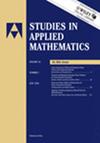零和非零边界条件下矩阵型非线性Schrödinger方程的N个双极解
IF 2.3
2区 数学
Q1 MATHEMATICS, APPLIED
引用次数: 0
摘要
本文针对离散谱为双极点的矩阵型非线性Schrödinger方程,分别在零边界条件和非零边界条件下的初值问题,建立了Riemann-Hilbert (RH)方法,这两种边界条件都包括直接散射过程(Jost函数、散射系数、反射系数的解析性、对称性和渐近性)和逆散射过程(剩余条件、赋范常数、RH问题和重构公式)。由于研究对象是矩阵型系统,我们将指出它与RH方法在研究标量方程和矢量方程方面的异同。比如我们必须假设k = k n∈C + $k=k_{n}\in \mathbb {C}^{+}$是det a (k)的三阶零$\det a(k)$ under rank (P (x, t,n) = 2⇔rank (a (n))) = 0 $\mathrm{rank} (P(x,t,k_{n}))=2 \left(\Leftrightarrow \mathrm{rank}(a(k_{n}))=0 \right)$,以此类推。本文章由计算机程序翻译,如有差异,请以英文原文为准。
N Double-Pole Solutions of the Matrix-Type Nonlinear Schrödinger Equation Under Zero and Nonzero Boundary Conditions
In this paper, Riemann–Hilbert (RH) method is developed for the initial value problem of matrix-type nonlinear Schrödinger equation with discrete spectrum as double poles under zero and nonzero boundary conditions, respectively, which all include the process of direct scattering(the analyticity, symmetries and asymptotics of the Jost function, scattering, and reflection coefficients) and inverse scattering (residue conditions, norming constants, RH problem, and the reconstruction formula). Since the object of study is a matrix-type system, we will point out the similarities and differences between it and the RH method in the study of scalar and vector equations, such as we have to assume that is a third order zero of under , and so on.
求助全文
通过发布文献求助,成功后即可免费获取论文全文。
去求助
来源期刊

Studies in Applied Mathematics
数学-应用数学
CiteScore
4.30
自引率
3.70%
发文量
66
审稿时长
>12 weeks
期刊介绍:
Studies in Applied Mathematics explores the interplay between mathematics and the applied disciplines. It publishes papers that advance the understanding of physical processes, or develop new mathematical techniques applicable to physical and real-world problems. Its main themes include (but are not limited to) nonlinear phenomena, mathematical modeling, integrable systems, asymptotic analysis, inverse problems, numerical analysis, dynamical systems, scientific computing and applications to areas such as fluid mechanics, mathematical biology, and optics.
 求助内容:
求助内容: 应助结果提醒方式:
应助结果提醒方式:


